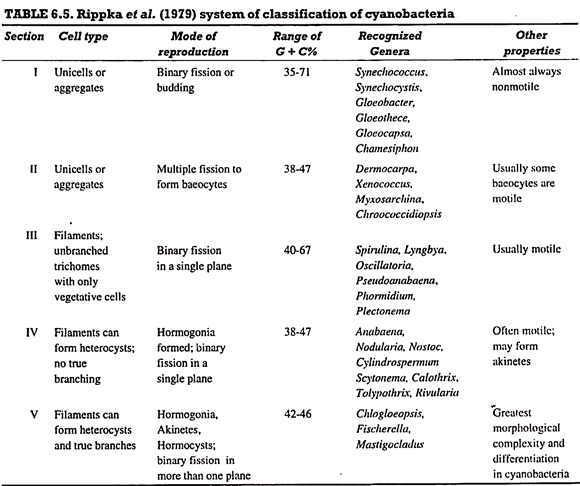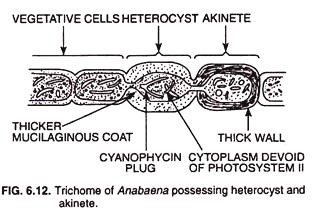In this article we will discuss about:- 1. Meaning and Characters of Cyanobacteria 2. Classification of Cyanobacteria 3. Reproduction 4. Parasexuality 5. Heterocyst 6. Economic Importance.
Contents
Meaning and Characters of Cyanobacteria:
The cyanobacteria (the earlier blue-green algae), or the blue-green bacteria, represent a group of photosynthetic, mostly photolysis-mediated oxygen-evolving monerans (prokaryotes).
These are the only organisms able to perform oxygenic photosynthesis that can also fix nitrogen. These organisms are amongst the oldest organisms known dating back to the early Precambrian period 3.6 x 109 years ago and probably played a crucial role in the evolution of higher plants.
Cyanobacterial thallus ranges from unicellular, colonial to filamentous; multi-seriate branched filamentous condition is the highest level of organization attained by them.
Because of their close architectural, physiological and biochemical similarities with bacteria, especially the gram-negative ones, the cyanobacteria have been placed under a separate division, namely, ‘The Cyanobacteria’ in Bergey’s Manual of Determinative Bacteriology (8th edition, 1974), which has been accepted and used widely as the standard reference for bacterial taxonomy.
This manual, however, has recognized the Kingdom-Monera of Whittaker, but has called it Kingdom-Prokaryotae because of the prokaryotic nature of all the monerans.
The cyanobacteria possess various distinguishing characters, which can be summarized as:
(i) Cyanobacteria can grow in diverse habitats, but one striking feature in their occurrence and predominance in habitats alternating between photo-aerobic and photo-anaerobic conditions can be correlated with their preference for low oxygen tension and low redox-potential. These properties stem from their recently discovered dual-capacity of oxygenic photosynthesis and facultative an-oxygenic photosynthesis,
(ii) The cyanobacteria possess various morphologically distinctive structures, e.g., akinetes and heterocysts.
(iii) The main cell wall constituent of cyanobacteria is peptidoglycan.
(iv) The cyanobacterial cytoplasm is traversed extensively by flattened vesicular structures called thylakoids or lamellae, the photosynthetic sites,
(v) The principal photosynthetic pigment of all cyanobacteria is chlorophyll a. Besides, they possess β-carotene and other accessory pigments, namely, phycobiliproteins. The phycobiliproteins are phycocyanin (PC), allophycocyanin (AP), allophycocyanin B (APB), and phycoerythrin, and
(vi) Most filamentous cyanobacteria show a gliding motility at some stage of development; they lack flagella.
Classification of Cyanobacteria:
Rippka (1979) have proposed a modern scheme of cyanobacteria classification taking mainly their physiology, cell constituents and DNA characteristics into consideration. They have created five sub-groups called ‘sections’. (Table 6.5)
Reproduction in Cyanobacteria:
Like bacteria, the cyanobacteria also reproduce asexually and the commonest mode of reproduction in them is transverse binary fission. In addition, there are certain specialized structures such as akinetes, hormogonia, hormocysts and spores, which are partly involved in the process of reproduction.
So far as the sexual reproduction in its true sense is concerned, it is absent in them and the requirements of sexuality are considered to be met by some alternative pathways referred to as parasexual-pathways.
1. Akinetes:
Most filamentous cyanobacteria develop perennating structures (dormant structures) in adverse condition. These structures are larger than the vegetative cells, are equipped with thick walls, and are called akinetes (Fig. 6.12). When favourable conditions return, they germinate and produce new filaments.
2. Hormogonia:
All filamentous cyanobacteria reproduce by fragmentation of their filaments (trichomes) at more or less regular intervals to form short pieces each consisting of 5-15 cells. These short pieces of filaments are called hormogonia. The latter show gliding motility and develop into new full- fledged filaments.
3. Hormocysts:
Some cyanobacteria produce hormocysts, which are multicellular structures having a thick and massive sheath. They may be intercalary or terminal in position and may germinate from either end or both the ends to give rise to the new filaments.
4. Spores:
Non-filamentous cyanobacteria generally produce spores such as endospores, exospores and nanocysts which contribute by germinating and giving rise to new vegetative cells when the unfavourable condition is over. Endospores are produced endogenously like those in bacteria; exospores are the result to exogenous budding of cells, and the nanocysts are produced endogenously like endospores.
The difference between an endospore and a nanocyst is that in endospore formation the parent cell concomittantly enlarges in size, whereas in nanocyst formation there is no such enlargement of the cell.
Parasexuality in Cyanobacteria:
The knowledge of cyanobacterial genetics is relatively new and was pioneered by Kumar in 1962 who obtained penicillin and streptomycin resistant strains of Anacystis nidulans, crossed them, and successfully demonstrated the appearance of a third type of recombinant strain resistant to both the antibiotics.
However, the mechanisms of genetic recombination in cyanobacteria are thought to be the same as those in bacteria.
The existence of the process of transformation in cyanobacteria was established experimentally in 1979 by Doolittle. Stevens and Porter in 1980 has successfully demonstrated this process in Agmenellum quadruplicatum. The transforming principle was shown to be DNA. Some cyanobacteriologists, however, have found that the transformation is mediated in some cases by complexes of DNA and RNA.
The first report on conjugation in a cyanobacterium, namely, Anacysts nidulans was by Kumar and Ueda in 1984. The frequency of conjugation is very low (about 1 in 106 cells) and cells conjugate by means of a conjungation tube.
The knowledge of transduction in these microorganisms at present is restricted to some preliminary reports. However, the occurrence of different cyanophages, e.g., LIP 1-7, SM-1, N-1 and infection of several cyanobacteria by them prompts one to imagine that the virus-mediated method of genetic transfer (transduction) in cyanobacteria may be conclusively established in the near future.
Heterocyst in Cyanobacteria:
As stated earlier, the cyanobacteria are the only organisms able to perform oxygenic photosynthesis that can also fix nitrogen; many, but not all, are vigorous nitrogen fixers.
The coexistence of the processes of oxygenic photosynthesis and intrinsically anaerobic nitrogen fixation process in a single organism presents an obvious paradox because nitrogenase, the key enzymes, is rapidly and irreversibly inactivated by an exposure even to low partial pressure of oxygen.
However, the nitrogen fixing cyanobacteria produce a specialized type of cell, the heterocyst, within which nitrogen is fixed.
Filamentous forms of cyanobacteria such as Anabaena form large distinctive cyst-like cells, the heterocysts, at intervals along the trichome (filament), (Fig. 6.12). The latter develop from normal vegetative cells particularly in conditions deficient in NH +3 or NO–3, and are considered to be the site of nitrogen fixation.
The conversion of atmospheric nitrogen to ammonia takes place under highly anaerobic conditions, that only the heterocysts are able to provide. For instance, the oxygen-evolving part of the photosynthetic mechanism (photosystem II) is blocked in heterocysts, and the remaining photosynthetic machinery becomes geared to provide energy for the reduction of nitrogen to NH3+.
Economic Importance of Cyanobacteria:
1. Cyanobacteria are one of the early colonizers of bare and barren areas and generate such conditions that favour the growth of other organisms even in the most hostile environment.
2. They are good food source for several aquatic animals. Moreover, the cyanobacteria are now-the-days exploited as food for animals including humans. Spirulina, a filamentous cyanobacterium, is now incorporated in food supplement as well as animal feed through ‘single cell protein’ manufacture because of its high protein content (upto 70%).
Some Indian dishes, for instance, like ‘puri’ ‘idli’ and ‘sandwich’ prepared by supplementing 5-10% S. fusiformis have been found to be palatable. In parts of Rajasthan Anabaena and Spirulina are collected from Sambar lake and used as fodder and manure.
3. N2-fixation is the characteristic feature of many cyanobacteria and this function is performed by heterocysts present in them. Aulosira, Nostoc, Anabaena, etc. are some such cyanobacteria that are now regularly inoculated in the rice fields for nitrogen supply. This saves consumption of nitrogen fertilizers.
4. N2-fixing cyanobacteria (e.g., Nostoc, Anabaena) are often used for reclamation of ‘user’ soils. They produce acidic chemicals for counteracting alkalinity of the soil and they supply nitrogen compounds which are generally deficient in these soils.
5. Species of Anabaena and Aulosira do not allow mosquito larvae to grow nearby. Such cyanobacteria can be inoculated in village ponds to prevent the growth of mosquitoes.
6. Extracts of Lyngbia are used to manufacture antibiotic-like compounds.
7. Certain cyanobacteria such as Microcystis aeruginosa (= Anacystis cyanea), Anabaena flos-aquae and Aphanizomenon flos-aquae produce toxins harmful to most aquatic animals. These toxins may prove equally harmful to humans drinking or bathing in such water.
8. Cyanobacteria generally grow on walls and roofs of buildings during the rainy seasons and cause discolouration, corrosion, and leakage.

